Purebred pups are celebrated with dog shows and pageantry, but we think doggos with mixed ancestry deserve love, too.
Often mislabeled as “hybrids,” mixed breeds can be striking in appearance and multi-talented thanks to their blended backgrounds.
Check out 23 of our favorite hybrids and get the scoop on that “hybrid” term below.
Hybrid Dogs: Key Takeaways
- The term “hybrid” refers to animals that are created when members of two different species breed. This includes familiar examples like mules and ligers, among many others. There are also a few examples involving domestic dogs, such as wolfdogs and coydogs.
- Because domestic dogs all belong to the same species, mixed-breed pooches are NOT examples of hybrids. However, many people use the term “hybrid” when referring to mixed-breed mutts. So, that’s what we’re doing here.
- We’re going to cover both true dog hybrids and regular ‘ol mixed-breed cuties below. Most true hybrids do not make good pets, whereas many domestic doggo combinations make fabulous family members.
What is a “Hybrid Dog” Exactly?
A hybrid animal is created by breeding two different species.
For example, you may have heard of a “liger” or “tigon,” which are different types of hybrids created when lions and tigers breed (the terms are applied differently based on the sex of the parent animals).
Other common examples of hybrids include:
- Mule (male donkey x female horse)
- Hinny (male horse x female donkey)
- Cama (camel x llama)
- Wolphin (false killer whale x bottlenose dolphin)
- Zony (zebra x pony)
- Beefalo (bison x domestic cow)
Because all domestic dogs are the same species (Canis familiaris), mixed dog breeds aren’t actually true hybrids. But, since people frequently use the term, we’re rolling with it.
There are, however, some true hybrids out there involving domestic dogs and other canids, and we’ve got them covered below.
True Hybrid Dogs: Wolfdogs, Coydogs, and Dingo-Dogs, Oh My!

There are four definite dog hybrids in existence today. These pups vary significantly in appearance, and depending where you live, may be illegal to own.
While beautiful in appearance, owning a true dog hybrid is not at all like owning a domestic dog — even large or “wolf like” breeds.
Domestic dogs are — wait for it — domestic animals, who’ve adapted to living alongside humans for tens of thousands of years. True hybrids, on the other hand, feature a wild canine parent, who will contribute numerous physical and behavioral characteristics that are quite different from those provided by domestic dogs.
Sadly, many true hybrids are surrendered to wildlife rescues or euthanized because they often become unmanageable or aggressive.
The known true dog hybrids are:
- Wolfdogs: A mix between a domestic dog and a wolf (Canis lupus), these are the best-known dog hybrids. Wolf-dogs can occur in the wild, though this isn’t common, as wolves and dogs generally have a contentious relationship. Wolves even predate on dogs from time to time.
- Coydogs: The result of a coyote (Canis latrans) and a dog, coydogs are possible but rare. Like wolves, the relationship between coyotes and domesticated dogs is typically not pleasant. Coyotes even hunt domestic dogs on occasion. Coy-wolves are far more common.
- Dingo-Dogs: Dingo-dogs are the result of breeding a dingo (Canis dingo) and a domestic dog. Free-roaming domestic dogs are increasingly common in Australia, resulting in more mating between the two species. Unlike other dog hybrids, dingo-dogs are common. Fun fact: the Australian cattle dog technically got its start as a dingo-dog.
- Jackal-Dogs: The offspring of a domestic dog and a golden jackal (Canis aureus), jackal-dogs are rare, but have occurred in the wild and captivity. The Sulimov dog is a relatively new breed derived from jackal-dogs.
There is another rumored dog hybrid out there, though the jury’s out on whether or not this is possible:
- Dog-fox: These would be the combination of a dog and any of several fox species. Some reports of so-called “doxes” exist, though no genetic specimens are on record for study. Dogs and foxes have differing amounts of chromosomes, so most scientists believe such a mating would result in nonviable offspring.
Dog “Hybrids”: Marvelous Mutts of Mixed Ancestry!

True hybrids aside, most people, when talking about “hybrid dogs” really just mean mixed-breed doggos! Or as they’re often lovingly called, “mutts.”
There are countless awesome mixed breeds in the world, but we’ve pulled some of those most common (and cool) ones to highlight using their most commonly known names. Of course, the personalities and looks of these pups can vary significantly, but we’ve covered the basics to give you a better picture of each pooch.
Check out these mighty mutts:
1. Golden Lab or Goldador (Labrador Retriever x Golden Retriever)

A combination of two of America’s most beloved breeds, the golden Lab isn’t always golden as his name implies, as he can also be brown, black, or even red.
As a Labrador mix, his coat can vary from the Labrador’s short coat to the golden’s long and luscious locks. He’s a moderate shedder, requiring weekly brushing to remove loose hair from his dense, double coat.
The golden Lab is a bird hunting dog at heart, so don’t be surprised if yours has an affinity (OK, maybe an obsession) with water and retrieving everything from tennis balls to pine cones. He’s also a high-energy pup that needs a good amount of daily exercise. With his exuberance for life and sweet nature, he makes an excellent family dog.
2. Labradoodle (Labrador Retriever x Poodle)

The Labradoodle has skyrocketed in popularity, with pup parents falling head over heels for this marvelous medium-sized mongrel.
He comes in a rainbow of colors, and his curly coat gives him an irresistible teddy bear look. This coat requires a fair amount of upkeep, however, including regular brushing to prevent tangles between professional grooming appointments every 6 to 8 weeks.
The labradoodle is a rambunctious breed who needs daily physical and mental exercise to tire his body and ever-curious mind. This makes him an excellent candidate for a job, which is why he excels as a therapy dog and agility superstar.
He’s also quite an agreeable pooch, never meeting a stranger (furry or otherwise). Because of this, he’s a treasured family companion who is usually tolerant of babies and small children.
3. Goldendoodle (Golden Retriever x Poodle)

The goldendoodle is another mixed breed megastar who inherits the curly coat of the poodle and the happy-go-lucky nature of a golden. He’s an incredibly friendly pup that’s a favorite breed in the service dog community, and his easy-going ways lend well to life as a family dog, too.
Grooming your goldendoodle can be arduous, with daily brushing a must to maintain a tangle and mat-free coat. His curl pattern can vary from loose to tight coils, and some owners choose to keep their pooch’s coat short for easier maintenance.
As a smart and energetic doggo, your goldendoodle needs daily exercise and consistent training to ensure he’s happy and healthy.
4. Chusky (Chow x Husky)

A powerful pooch equipped for cold-weather fun, the chusky is as unique in his looks as he can be in his unique bark vocalizations.
He’s a confident canine with an independent streak, making early obedience training a must. The chusky’s also born to work, so regular exercise is important, along with regular mental stimulation.
Prepare for hair tumbleweeds around the house with a chusky, as this furry friend is a heavy shedder.
Invest in a good Husky-suitable brush and commit to regular brushing to keep the furry flyaways at bay. Note that your chusky may be aloof with stranger people and dogs, so early socialization is required to prevent issues.
5. Chiweenie (Chihuahua x Dachshund)

A pint-sized pooch with a giant personality, the Chiweenie has loads of energy. Despite being such a playful pupper, a daily walk and indoor play can satisfy his exercise needs, and he makes an exceptional dog breed for apartment living.
This dachshund mix may be at risk for back problems if he takes after his dachshund parent’s build, making careful lifting a must along with avoiding too many stairs or rough play. Luxating patellas and eye issues are also risks to watch for.
6. Puggle (Pug x Beagle)

A bubbly breed, the puggle’s a natural-born clown who loves to play and meet new friends. His gentle spirit suits a life with small kiddos and other pets.
He’s an active pup, but as a relatively low energy dog breed, a stroll around the block and some indoor play will meet his needs just fine.
While adorable with his smooshed face, your puggle can be susceptible to breathing issues in extreme cold or heat, as is common in pugs and pug mixes. He’s also prone to gaining weight quickly, so monitor his eating and make sure he gets his daily steps in.
7. Saint Bernewfie (St Bernard x Newfoundland)
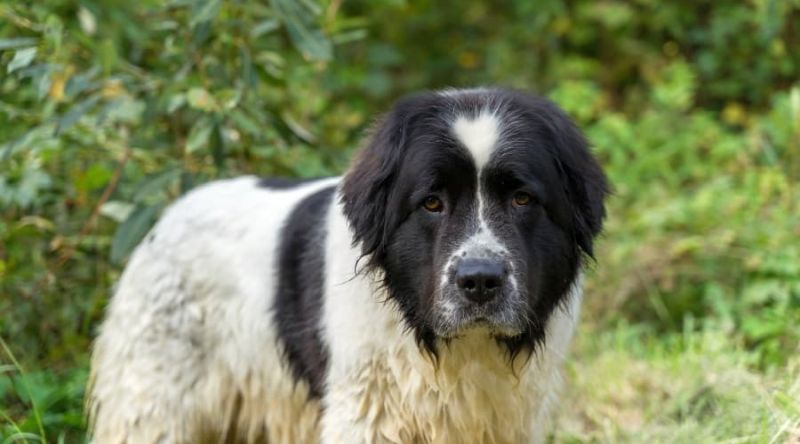
A gentle giant with a heart of gold, the Saint Bernewfie is a family dog through and through.
While he’s a lovable oaf, he sometimes forgets his size, which means early training is essential in teaching him manners before he gets too large. Frequent brushing of his thick, double coat is needed to prevent tangles, and prepare yourself for heavy seasonal shedding and drooling around the house.
Since he’s such a large doggo, he’s at risk of joint issues, like hip dysplasia.
Make sure your Saint Bernewfie maintains a healthy weight to lessen his chances of orthopedic problems and feed a high-quality food specifically designed for large breeds to nurture his growth.
8. Shorkie (Shih Tzu x Yorkie)
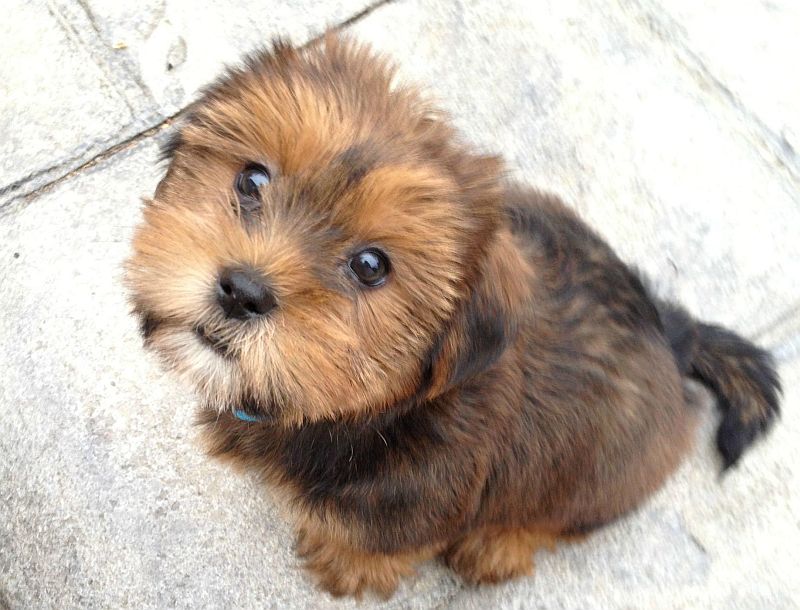
Toy-sized and sassy, the shorkie is as loyal as he is adorable. Perfect for city dwellers, a daily walk and some indoor playtime will meet his exercise needs.
He can be a big-time barker though, so teach your little friend to use an inside voice from an early age to prevent upsetting your neighbors. He can be stubborn, which means you should expect some boundary-pushing here and there.
Hair care is the biggest hassle of owning a shorkie (or any shih tzu mix for that matter), but regular grooming appointments and brushing at home will keep him looking sharp with his long locks. He’s a great companion for adults, but kiddos may not be the best match for this persnickety pup.
9. Valley Bulldog (Boxer x Bulldog)

The valley bulldog is a low-riding cutie with an expressive mug. He’s a goofy ball of energy and fun, making him a top-notch family dog.
Your valley bulldog’s exercise needs can be met with a daily walk and backyard play, but use caution in the heat because of his short snout.
The valley bulldog may inherit any of the numerous health problems of his parents’ breeds, including joint issues and breathing trouble that can be found in bulldog mixes as well as boxer mixes. He’s also prone to gaining weight quickly, so encourage your doggo to keep a svelte frame through regular exercise and a measured diet.
10. Cockapoo (Cocker Spaniel x Poodle)
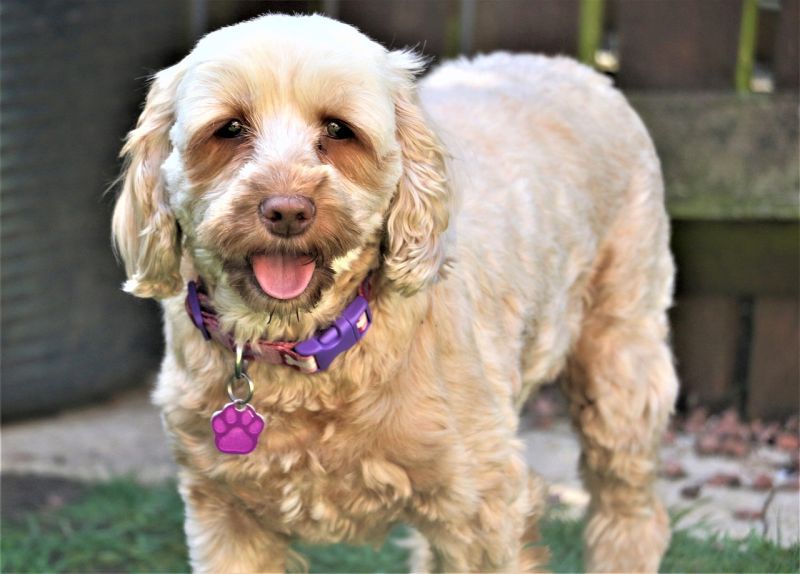
A longtime favorite, the cockapoo is a playful pup with a plush, curly coat.
His coiled ‘do can be kept long or short, though frequent brushing is needed to prevent matting. Professional grooming is recommended every few weeks to keep your cockapoo looking his best.
As a poodle mix and cocker spaniel mix, he’s a lot like his parents in that the cockapoo is a people-pleaser at heart and excels in training. This makes him an exceptional pick for first-time dog owners.
The cockapoo is also a wonderful fit in a family with kids and other pets.
11. Frenchie Pug (French Bulldog x Pug)

The French pug is a dapper doggo with a stocky build. He’s not exactly an athlete, but he’s a playful pup at heart, which makes him the perfect buddy for a family with kids.
His short coat sheds regularly and requires occasional brushing to remove loose hair. His wrinkles should also be kept clean and dry to avoid irritation.
As a French bulldog mix, these guys are susceptible to health problems, including eye disease and luxating patella. Never leave your Frenchie pug in extreme temperatures for long, as his short muzzle makes breathing extremely difficult. He’s also at risk for ocular injury due to his large eyes.
12. Schnoodle (Schnauzer x Poodle)

The schnoodle combines the saucy temperament of a schnauzer mix with the quick-wit of a poodle. He’s a bright little guy who loves to please, which means he’s a wonder to train and a perfect choice for a newbie dog owner. He’s also a friendly pooch who’ll make an excellent family dog.
Grooming is a regular responsibility with a schnoodle, and in addition to regular brushing to prevent mats, your schnoodle needs professional grooming every few weeks to keep his coat in tip-top shape.
His coat comes in a wide array of colors, and he may get his poodle parent’s curly coat or the harsher hairs of a schnauzer.
13. Morkie (Maltese x Yorkie)

The Morkie’s an intelligent toy breed who’s easier to train than most other small dogs. He’s a solid choice for a first-time pup parent and adapts well to apartment life. However, because of his size and fragility, he isn’t the best optional for families with small children.
Like other Maltese mixes, your Morkie probably doesn’t need much exercise, as this playful little clown can burn off his energy with indoor play before curling up in your lap.
His coat needs a fair amount of grooming, with daily combing a must to prevent mats. A sanitary trim is also a good idea to keep his rear area clean.
14. Daniff (Great Dane x Mastiff)

The Daniff is large and in charge — literally.
As a Great Dane mix, he can tip the scales at over 200 pounds, and he can also be quite stubborn and think he rules the roost. This makes puppy obedience training essential before he gets too big to control. Just keep training positive and reward-based, as he has a gentle spirit hiding under those big jowls.
Your Daniff needs a daily walk to stay in shape, and a drool cloth should be kept on hand around the house (and especially near the water bowl.) Health concerns are something to watch for with Daniffs, as joint issues and bloat can occur in the breed.
15. Cavachon (Cavalier King Charles Spaniel x Bichon)

If you’re looking for a lovable lapdog, look no further than the Cavachon.
This long-haired cutie is on the smaller side, but he’s still sturdy enough to play and live with kids without issue. His beautiful Bichon-mix coat requires regular upkeep, so nab the number of a good groomer and expect to visit every few weeks.
The Cavachon is a sweetheart, and this all-around friendly nature makes him a therapy dog favorite. He’s also intelligent and fairly easy to train, which means first-time dog owners fare well with him.
16. Pit Pei (Pit Bull x Shar Pei)
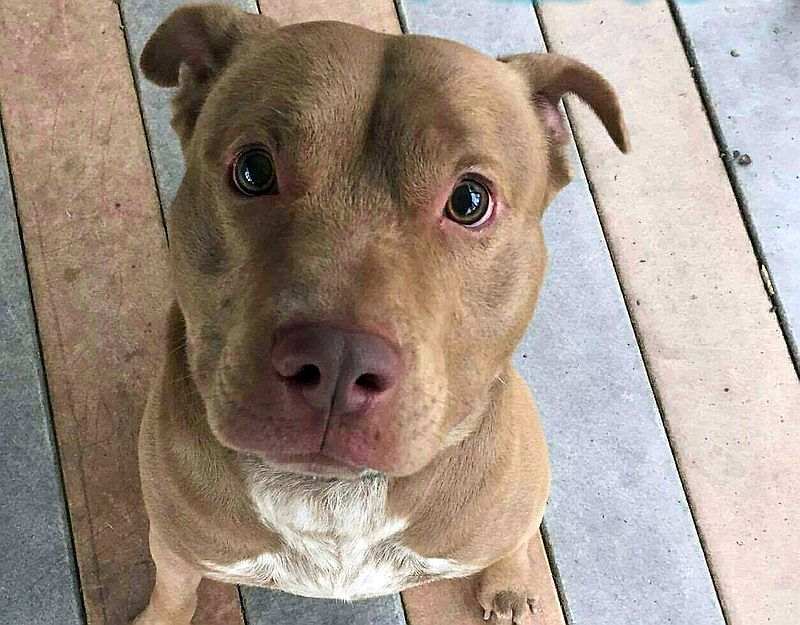
This wrinkly cutie is an athlete and a cuddle buddy all in one. Daily exercise is best for your pit pei, and he’s a natural in doggo sports like agility and obedience thanks to his intelligence.
While he is smart, he can be stubborn, so start his training early and keep it positive and consistent. Your pit pei will also need ongoing socialization with people, dogs, and other animals to avoid aloofness.
Pit peis can be prone to several health conditions, including eye disease, hip dysplasia, and skin disorders. Special care is also required to keep his wrinkles, which are common in shar-pei mixes, clean and dry to prevent skin irritation.
17. Bullmatian (Bulldog x Dalmatian)

The bullmatian is a medium-sized pooch who’s packed with energy and a thirst for adventure. He loves nothing more than playing, which makes him an awesome companion for a family on the go.
His stubbornness is legendary, however, so early and ongoing positive-focused training is best.
Your bullmatian’s coat is short and easy to maintain, but if he inherits his bulldog parent’s wrinkles, you’ll need to monitor them for signs of irritation and keep them clean.
The bullmatian can also suffer from several notable health issues, including joint issues, bladder stones, and heart conditions.
18. Peekapoo (Pekingese x Poodle)
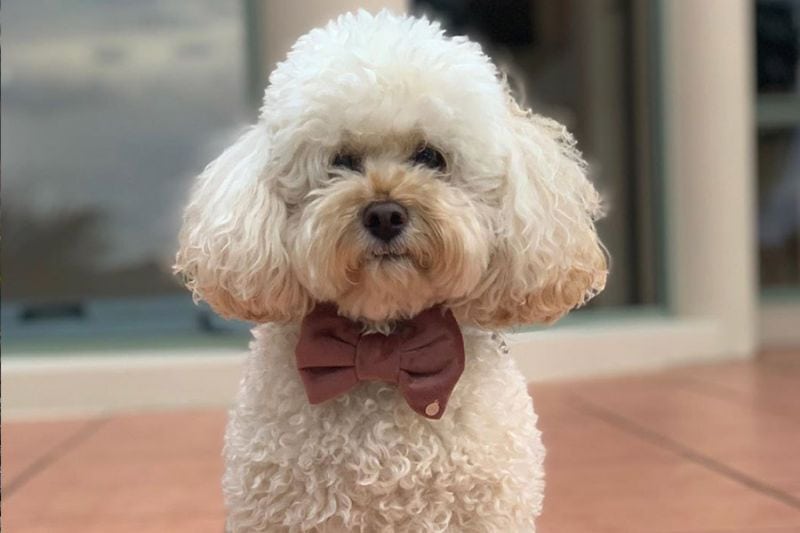
Apartment dwellers will adore the peekapoo — a small fry that’s an easy keeper. While playful, his exercise needs can be met with indoor fun or a daily stroll, and he’s happiest when he’s with his people (or, more specifically, on his people.)
Your peekapoo’s coat can be hard to manage, as the long, curly locks must be brushed regularly. You can make daily grooming easier by opting for a short clip.
The peekapoo has a few health concerns to watch out for, like luxating patella, and he’s sensitive to extreme temperatures because of his short muzzle.
Hybrid Dog Breed FAQs

With all this hybrid talk and the misconception surrounding it, it’s no surprise that questions about mixed breeds are common. We’ll tackle a few of the most common queries about mixed breeds and hybrids below!
Can dogs mate with wolves?
Yes. In the wild, this is rare, since wolves and dogs are territorial and typically have an acrimonious relationship. However, wolf-dog hybrids are bred in captivity more commonly than you’d think. Sadly, many end up in wildlife rescues because of their challenging demeanor.
Can dogs mate with coyotes?
Yes. Like wolf-dog hybrids, coydogs are rare in the wild, but they can happen. In fact, when analyzed, the genetic makeup of some northeastern coyote populations has been found to contain about 10 percent domestic dog. Many wild coywolves are mistakenly labeled as coydogs.
Can dogs mate with foxes?
It is unlikely, but still unknown. The existence of fox-dogs or “doxes” is debated between scientists. There are only a handful reported in history, and genetic material hasn’t been examined to confirm the specimens’ lineage.
What is the most popular crossbreed dog?
It’s hard to say, as mixed breeds aren’t as well-tracked as purebreds. Mixed breeds aren’t always correctly labeled by shelters or rescues, either. However, poodle crossbreeds are one of the most common today, as seen in labradoodles, goldendoodles, cockapoos, and more. Chihuahua, pit bull, and lab mixes are also incredibly common.
Can a dog be mixed with more than two breeds?
Absolutely. In fact, many pup parents who test their mystery mutt’s DNA come up with a handful of breeds in their pupper’s results. Mutts of mutts are very common (and super cool!)
Are crossbred dogs healthier than purebreds?
Maybe. The answer depends on the breeds involved, for one, as certain dog breeds are prone to serious health conditions. Mixing a breed with another can help reduce issues with physical traits, like a bulldog’s short snout, but it can pass on hereditary conditions, such as hip dysplasia. That said, the principle of hybrid vigor shows sometimes that hybrid offspring have better health than their parents. The breeding can make certain traits more prominent, such as strength. This isn’t always the case, but it’s worth noting.
***
Do you have a mighty mixed breed at home? What breed combo is your pooch? Does he take more after one breed than the other? Let us know in the comments!
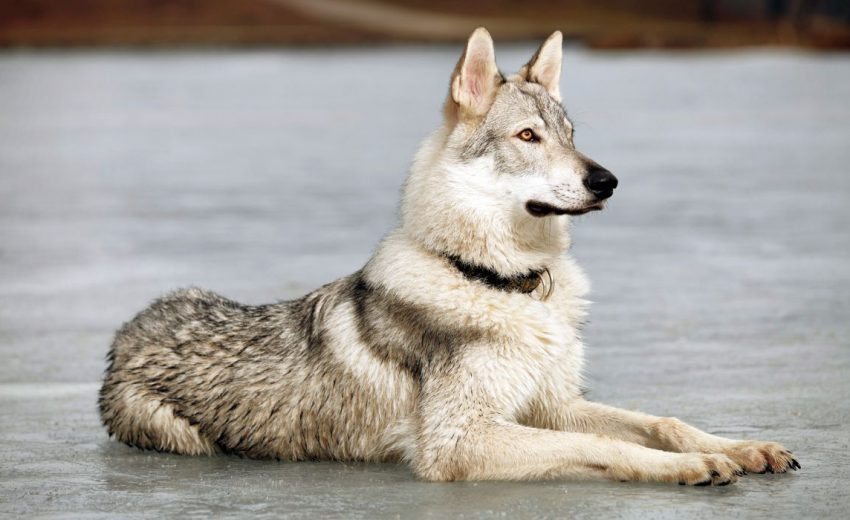







7 Comments
January 15, 2022
What is the weight and height of Cavachon?
January 17, 2022
Hey, Jaty.
Mixed-breed doggos can vary quite a bit, but most Cavachons are likely in the 20 to 30 pound range and stand about 12 inches high at the shoulder.
🙂
July 13, 2021
so i have a mixed dog but me and my dad don’t know the breeds
July 13, 2021
That’s a common issue, Kiley!
Check out some of the dog DNA tests on the market — they should help!
May 11, 2021
our dog is 10 + breeds
February 1, 2021
Are there any guard dogs for first time owners like the BOXER DOG
February 1, 2021
Are there any K-9 Hybrid useful as guard dogs, watchdogs and personal protection dogs especially for first time owners